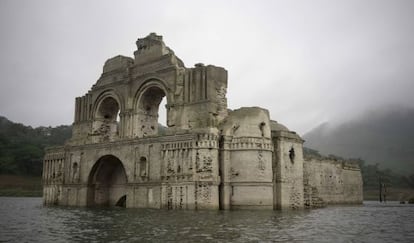Historic church resurfaces as drought dries up Mexico’s rivers
Low rainfall sees immersed 16th-century temple reemerge in Chiapas waterway


The fast-flowing rivers of southeast Mexico hide valuable treasure. Dropping water levels caused by lower-than-average rainfall have revealed the remains of a 16th-century church built by Dominican monks in the north of what is now the state of Chiapas.
The Quechula Church is 61 meters long and has been under water since 1966 when the Malpaso Dam was completed on the Grijalva River.
When water levels drop, the local fishermen turn into guides, taking tourists out to admire the remains
Water levels along the 600-kilometer waterway – the country’s second longest – are now critically low. They have been decreasing since May as a result of the impact of the current phase of the El Niño weather cycle, which has cut rainfall by half in this lush green area accustomed to torrential tropical storms.
Four dams depend on the Grijalva River, including Malpaso Dam, which serves an important hydroelectric plant that provides energy for several southeastern states.
Video: Inside the reemerged church (Spanish voiceover).
In August, the river’s water level was 11 meters below average and may have fallen far further since then as experts say the church can only be seen when it dips below 25 meters. The last time the church emerged was in 2002 when several worshipers walked to the building to celebrate a Mass.
Carlos Navarrete, an architect who wrote a report on the remains of the church for the Mexican government, says the building was abandoned between 1773 and 1776 after a series of plagues struck the communities of the region that is today inhabited by the indigenous Zoque people.
Before the completion of the dam in 1966, there was a small village near the church, a community of four neighborhoods, each one named after a saint. Relatives of the former residents say the church was known as the Iglesia de Santiago.
When water levels drop, the local fishermen turn into guides, taking curious tourists out to admire the remains of the old church in their small boats. Some of them say an earthquake destroyed one of the 10-foot walls in the 1940s.
English version by Dyane Jean François.
Tu suscripción se está usando en otro dispositivo
¿Quieres añadir otro usuario a tu suscripción?
Si continúas leyendo en este dispositivo, no se podrá leer en el otro.
FlechaTu suscripción se está usando en otro dispositivo y solo puedes acceder a EL PAÍS desde un dispositivo a la vez.
Si quieres compartir tu cuenta, cambia tu suscripción a la modalidad Premium, así podrás añadir otro usuario. Cada uno accederá con su propia cuenta de email, lo que os permitirá personalizar vuestra experiencia en EL PAÍS.
¿Tienes una suscripción de empresa? Accede aquí para contratar más cuentas.
En el caso de no saber quién está usando tu cuenta, te recomendamos cambiar tu contraseña aquí.
Si decides continuar compartiendo tu cuenta, este mensaje se mostrará en tu dispositivo y en el de la otra persona que está usando tu cuenta de forma indefinida, afectando a tu experiencia de lectura. Puedes consultar aquí los términos y condiciones de la suscripción digital.
Últimas noticias
The complicated life of Francesca Albanese: A rising figure in Italy but barred from every bank by Trump’s sanctions
From digital curfews to blocking apps: How technology experts protect their children online
Why the price of coffee has skyrocketed: from Brazilian plantations to specialty coffee houses
Confined to a Cuban hospital: When electricity is a matter of life or death
Most viewed
- Pablo Escobar’s hippos: A serious environmental problem, 40 years on
- Why we lost the habit of sleeping in two segments and how that changed our sense of time
- Trump’s obsession with putting his name on everything is unprecedented in the United States
- The Florida Keys tourist paradise is besieged by immigration agents: ‘We’ve never seen anything like this’
- Charles Dubouloz, mountaineering star, retires at 36 with a farewell tour inspired by Walter Bonatti








































